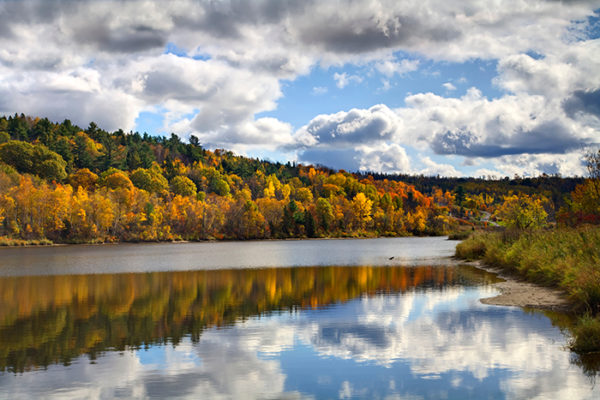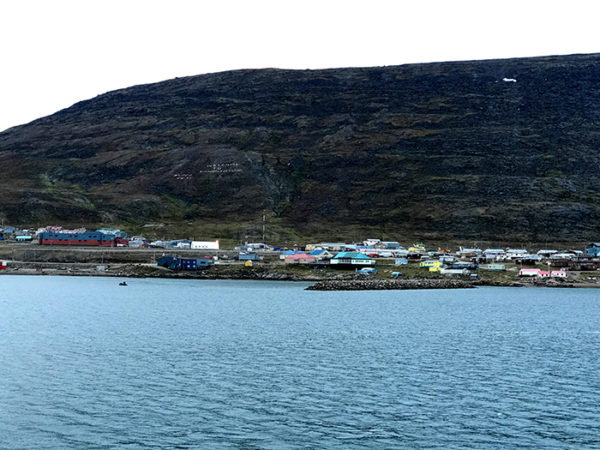Fieldnotes: Nature can protect us from climate change now
How nature can help protect us from climate change right now

In the last edition of Fieldnotes, we talked about using nature-based solutions to help fight future climate change by protecting, restoring and expanding carbon-capturing forests, wetlands and grasslands. But nature can do more than help us reduce emissions — it can also help us deal with the disastrous effects that are already here.
“Climate adaptation is about our response to climate change,” explains WWF-Canada’s Simon Mitchell, who helps small communities in the Saint John River watershed withstand ever-increasing floods. “In a lot of instances, it’s putting in rain barrels and rain gardens; it’s those individual actions that we take to respond to the changing climate.”
But Mitchell’s work in New Brunswick — which involves identifying vulnerabilities and bringing local groups, experts and governments together to implement nature-based solutions — goes beyond adaptation to resilience.
Climate resilience is the ability to bounce back
When we get climate-related events like flooding and storm damage, communities, individuals, businesses and the natural environment need to be able to bounce back to a stable state. Wetland restoration, for example, can be considered adaptation but may not be resilient if it hasn’t been done properly.
“Wetlands can be like buffers along edges of rivers,” Mitchell explains, “and if managed in a way that allows the river to expand and contract, without degrading its ecological functioning, this would be considered a resilient solution.”
WWF’s goal is to help these communities move from vulnerability to resiliency by restoring the river’s ability to cope and respond, like planting trees and stabilizing banks to ensure it can handle climate change-increased water flows during the spring thaw and other flooding events.
“Resilience includes the adaptive capacity of ecological systems, and ultimately contributes to how successful nature-based solutions are”.
Join WWF at the Global Climate Strike!

While world leaders prepare to meet on Sept. 23 at the UN for climate talks, millions of regular folks around the world are preparing to meet at the Global Climate Strike on Sept. 27 to demand climate action. There are hundreds of protests planned in towns and cities around the world, including Canada.
The WWF-Canada team will be marching at the Global Climate Strikes in Toronto, Montreal, Ottawa, St. John’s, and Halifax so if you see us, come say hi!
Check out our Climate Strike page to find out why we’re marching and what this movement is all about. There’s info to help you join a strike, including a map to find one near you. It’s time to come together, make ourselves heard and fight for our future.
Powering Nunavut’s future with renewable energy

Transitioning to renewable energy is key to fighting the climate crisis — and it’s possible everywhere, including Nunavut where their electricity, heating and transportation is almost exclusively diesel. WWF-Canada has just released a feasibility study of 25 Nunavut communities to show how this could happen. Martha Lenio, our expert on Arctic renewables, breaks down our new report’s findings.
First off, what is habitat-friendly renewable energy?
Renewable energy projects are often large infrastructure projects, so if they’re not done right they can end up having negative impacts on wildlife – everyone’s heard that wind turbines can kill birds, and large-scale hydro projects can end up flooding critical habitats. So we’re talking about ensuring renewable energy projects happen in a way that safeguards and protects the environment by getting us off fossil-fuel powered energy and slowing climate change, and at the same time ensuring habitats stay intact.
What did we learn from this feasibility study?
The finances around renewable energy projects are changing – the cost of solar panels has dropped by about 40 per cent over the past three years, and battery costs have also come down significantly. The presence of the carbon tax on diesel for heating also affects the financial outlook for green energy projects. What we learned is that there are a few communities in Nunavut where switching to some level of renewable energy makes sense immediately. We also learned that there are a lot of communities that are close to a financial case for renewables, and the exact project details and how the project will be financed makes a huge difference.
Why is it important for Nunavut to transition off diesel?
Environmentally, there’s always a risk of a major diesel spill. Diesel is shipped up by boat once a year and stored in large tank farms in each community. A diesel spill at sea would be difficult to clean up and would have a negative impact on marine wildlife and, as a result, food security. Diesel spills on land damage the permafrost which can affect the foundations of buildings and damage infrastructure. Spills could contaminate a community’s water supply.
In terms of health, diesel exhaust is recognized as a carcinogen by the WHO, and likely contributes to the higher rates of lung diseases in Nunavut. Since the cost of energy from diesel is so high, the Government of Nunavut has subsidy programs to make energy more affordable to Nunavummiut. But spending so much on energy subsidies takes funds away from investing in other needed priorities across the territory so looking at alternatives to diesel is important for a lot of different reasons.
What about creating new, green industry jobs?
There’s not a lot of expertise yet in terms of solar and wind energy in Nunavut, but there’s a great desire for more knowledge. Now that a lot of the policy changes are being realized, WWF is focusing on green energy education and training programs for Nunavummiut so they can participate more fully in the energy transition, and really be the leaders in making changes in their communities that make sense for them.

Meet a… Scientist
James Snider, Vice-President, Science, Research & Innovation
A veteran of WWF-Canada for the past dozen years, James leads the SRI team.
He ensures our conservation efforts are cutting-edge, helms our Living Planet Report Canada. He is also spearheading our new Living Planet Technology Hub showcasing the advanced tech we use to help protect nature.
“We are in the midst of dual crises of biodiversity loss and climate change. Now is the time for Canada to show the world how protecting nature will have clear benefits for climate, people and wildlife.”

